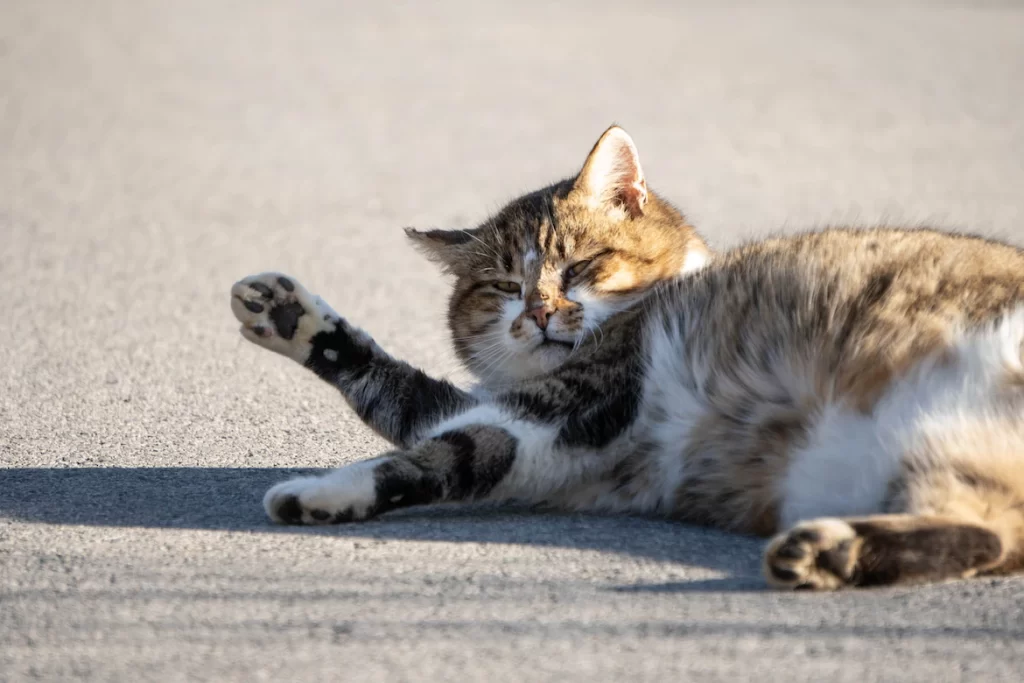Last updated on February 12th, 2023 at 01:16 am

Is your cat expecting? Cats are famed for their independence and low maintenance, and this extends to feline pregnancy as well. However, there are several areas where the prospective cat mom (also known as a queen) may require a bit extra attention. If you do not intend to breed your cat, it is always a good idea to get her spayed. Cat pregnancy is a huge event, and if you’ve made the big decision to allow your cat to produce kittens, you’re in for a wild ride. The question is, how to take care of a pregnant cat?
We strongly advise cat owners to spay and neuter their cats in order to reduce cat overpopulation and health problems. That being said, if a cat already has babies in her belly — which is often the case if you encounter a stray female cat — here’s what you should know and do for a pregnant cat.
What Are The Signs Of A Pregnant Cat?
If you didn’t realize your cat was pregnant, you may notice her belly becoming larger and rounder, as well as her nipples, becoming swollen and more visible. You may notice milk emerging from her nipples (lactating) or that she has a greater appetite.
As the pet gets near to giving birth, she will nest and seek out a secluded, warm, dark location to spend her time as she prepares to give birth. She will usually give birth in this peaceful location, away from traffic and noise.
If you suspect your pet is pregnant and want to confirm it, your veterinarian can do some diagnostic tests. An ultrasound can be performed to identify fetal heartbeats and show kittens in the uterus if the cat is about 25-35 days along. Not every veterinarian facility has an ultrasound machine, and the test may be a little more expensive. If the pet is 45 days or more along, a radiograph, or x-ray, can be used to locate the fetal skeletons and estimate the number of kittens she will give birth to. Your veterinarian may be able to palpate kittens depending on how far along the cat is and the state of the animal’s body. Cats are pregnant for around two months or 60-63 days. Because their gestation period is so brief, a pet might become pregnant multiple times per year.
How to Take Care of a Pregnant Cat?
To take care of a pregnant cat, you need cooperation. Your cat will need your care before the kittens arrive to ensure a safe and successful pregnancy. Along the way, you’ll require the assistance of your veterinarian. Working together, you, your cat, and your veterinarian will dramatically boost the chances of a happy, healthy litter of kittens. Here are some helpful hints for caring for a pregnant cat.
Get Help From a Veterinarian
If your cat is displaying signs of pregnancy or you suspect she mated while in heat, the first step is to take her to the veterinarian. Sometimes it is still early enough to spay your cat. It is difficult to confirm a pregnancy in a cat until it is three to four weeks pregnant. However, if your cat appears ill or exhibits unusual symptoms, you should still take her to the doctor for an examination and inform the vet that she may be pregnant.
Your vet may be able to determine pregnancy by gently palpating your cat’s abdomen approximately three weeks into the pregnancy, though this can be difficult if the cat is obese or other factors such as solid stool or a large bladder are present. An ultrasound, if available, may be used to confirm pregnancy.
During the early to the mid-pregnancy stage, your veterinarian might discuss the possibility of spaying your cat and terminating the pregnancy with you. You may decide to do so for the sake of your cat’s health or to reduce cat overpopulation.
If you decide to let your cat have the kittens, your veterinarian may advise you on how to care for your pregnant cat as well as the care the kittens will require after delivery. This is an excellent opportunity to consider how you can locate suitable homes for kittens.
Your veterinarian may recommend a radiograph (X-ray) at 55 days into the pregnancy to determine the number of kittens expected. If you know how many fetuses your cat is carrying, you’ll be able to tell when she’s completed giving birth or if she’s in pain in between kitten births. Vaccinations are not suggested during pregnancy because they may harm the development of the kittens, while certain forms of rabies vaccine may be safe.
Feeding
If you suspect your cat is pregnant, don’t make any modifications to its cat food without first consulting with your veterinarian. Overfeeding or underfeeding your cat can complicate pregnancy. During the first visit, consult with your veterinarian to develop a suitable feeding plan and adjust your cat’s diet accordingly. Your veterinarian may advise you to feed a higher-calorie kitten chow or mix wet food in with the normal kibble. The extra calories help in milk production and the development of the kittens.
To care more for your pregnant cat, avoid overfeeding them during the first several weeks of her pregnancy. Yes, she requires adequate nutrients for herself and her kittens. The kitten food, on the other hand, contains the extra calories and nutrients she requires. She and the kittens may have problems if she grows overweight.
After you have confirmed her pregnancy, gradually transition to kitten food, but do not increase the amount she is fed unless she is underweight or seems hungry. Your veterinarian can help you monitor her body condition during her pregnancy.
When your cat is around six weeks pregnant, she should be fed smaller, more frequent meals. The kittens’ pressure on her stomach makes it difficult for her to consume much at once, yet she desperately needs the extra nourishment. Provide her with little meals four to six times per day.
Environment
Aside from modest vet care and dietary changes, your pregnant cat should have no particular needs for the majority of her pregnancy. However, as she approaches queening (giving birth), she will begin to look for a safe, peaceful area to begin nesting. This normally starts a day or two before the baby is born.
Filling a cardboard box or laundry basket with blankets and hiding it away in a safe, quiet place of your home will help you prepare it. Your cat, on the other hand, may decide not to utilize it. They’ll do anything they want, as most cats do. Your cat may choose the most inconvenient location to give birth.
If you wish to keep certain areas of the house off-limits for queening, make sure they remain closed throughout her last week of pregnancy. Also, make sure she has no access to the outdoors, as she may sneak away to nest somewhere you won’t be able to find her. As the birth date approaches, your cat may get restless and even agitated. This is quite normal. Just try to keep her comfortable and give her some room. Everything will be over soon.
Cat’s Behavior
During the first few weeks of pregnancy, your cat will behave normally. However, she may soon begin to sleep more. Some meals may be missed as a result of increased sleep. You can help her eat by waking her up at feeding time or by displaying the food and water in her dishes as a reminder. You may notice that they frequently lick her teats as delivery approaches—don’t panic, this is normal. When the teats become clogged with milk, they can become painful, and licking has a relaxing effect that helps relieve the pressure.
Supplements and Vitamins
In general, a pregnant cat does not require any vitamins or supplements. She does not require any additional supplements if she is fed a high-quality diet; in fact, doing so can be extremely dangerous. Some queens may develop eclampsia, also known as milk fever, as a result of low blood calcium levels in the latter stages of pregnancy or, more commonly, during lactation.
Speak with your veterinarian about this, especially if you feed a homemade diet. Calcium supplementation is not recommended during pregnancy because chronic high calcium levels can depress parathyroid gland sensitivity. During lactation, however, your veterinarian may advise you to take calcium supplements. Never start taking this or any other vitamins without first consulting a veterinarian.
Deworming
Roundworms, hookworm, and tapeworm are the most prevalent worms in cats. All cats should be wormed on a regular basis; this is especially crucial during pregnancy because hookworms can encyst in the cat’s tissues and remain latent; when the cat gets pregnant, they migrate to the queen’s mammary glands and are transferred in the milk when the kittens feed. Roundworms could also infect kittens during pregnancy by passing through the placenta. Worming products cannot kill worms that have become engorged in the tissues or mammary glands, but they can kill worms that have become engorged in the queen’s intestines.
The following is the suggested protocol:
- During pregnancy, every three weeks.
- During nursing, every three weeks (until weaned).
However, before treating your cat for worms, consult with your veterinarian. Do not use over-the-counter worming products; instead, follow your veterinarian’s recommendations for worming products and frequency.
Litter Trays
Your pregnant cat will grow increasingly uncomfortable as the pregnancy advances. It is not unusual for a very pregnant cat to have an accident. Please keep in mind that your queen will be enormous, quite uncomfortable, and moving about will be more difficult than usual. Provide her with a litter tray that she can easily climb into and out of.
Preparation for Birth
There isn’t much you need to do for your pregnant mother in the months leading up to the delivery; just make sure she continues to have good, balanced food and plenty of water.
As soon as you know she’s pregnant, move her to premium kitten food to provide extra nutrients for her and her offspring. Continue to feed her this food until the kittens are weaned. Don’t be surprised if your mother cat doesn’t appear to eat much at first. She has an abdomen full of kittens and would most likely prefer to feed in modest bits several times a day.
As the due date approaches, your cat will most likely begin hunting for a quiet, comfy area to nest. Provide your cat with a towel-lined box and encourage her to use it. Don’t be alarmed if she decides not to utilize it in the end. A creamy discharge from your cat’s nipples usually indicates that she is about to give birth. If you keep track of your cat’s temperature, it will normally go below 38.9 degrees Celsius just before delivery.
When Your Cat Is Ready to Have a Baby
Once your cat has decided where she wants to give birth, you should leave her alone and observe from a safe distance. Fortunately, most cats require little to no human assistance when it comes to queening. However, if she is in distress, you may need to intervene.
Keep note of how long it takes between births and make sure you know how many kittens to expect. If your cat has visible contractions for more than 60 minutes without kitten birth, contact your veterinarian. Also, contact the veterinarian if more than two hours pass without the following kitten’s birth.
If a kitten remains in the birth canal for more than a minute or two without being pushed out, take your cat to the vet immediately. If anything else appears to be wrong, contact your veterinarian.
Avoid separating mom and kittens for the first few days, and make sure to continue to feed the momma cat, whose caloric needs will increase significantly while she is lactating and feeding her kittens. Instead, take them all to the vet around 6 weeks of age for a check-up. If you do not breed purebred cats, consult your veterinarian about having your cat spayed as soon as possible. This is frequently done after the kittens have been weaned.
Conclusion
Things happen unexpectedly, especially during pregnancy. Whether we like it or not, we must take responsibility when our cat gets pregnant. There’s nothing much you can do aside from being there during their pregnancy journey. To care for a pregnant cat, make sure to give them proper food and nutrition, as well as a calm and clean environment. We hope that this article gives you a lot of information on how to handle a pregnant cat. For more information and care, consult your veterinarian and ask for the proper caring that your cats need.


